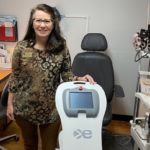
Dr. Reinholdt with the low-level laser therapy instrument that is part of the suite of advanced instrumentation she uses as part of her practice’s medical eyecare services. Getting credentialed with medical insurance providers has greatly improved her practice’s profitability.
By Renee Reinholdt, OD
July 20, 2022
Getting credentialed with medical insurance providers can greatly enhance your practice’s profitability. Here is how I did it, and how doing this helped me expand my medical eyecare services and financial growth.
Why Do It?
I wanted to practice full-scope optometry. I wanted to get paid for the services I provided like any other medical provider. Many optometrists do themselves a disservice by not becoming credentialed on medical insurance networks. We are the primary care doctors of eyecare. We are often the first provider the patient sees who diagnoses autoimmune disease, hypertension and diabetes based on our clinical findings.
My average medical patient provides almost double the revenue per patient compared to the cash pay routine exam fee and about four times more than the typical reimbursement from vision plans. My typical day is 60 percent medical insurance, 30 percent vision plans and 10 percent cash pay.
How Do You Do It?
Medical insurance companies have credentialing applications that must be filled out. Optometrists need a tax ID number, NPI number, optometry license in hand and an office address before starting these applications.
Remember, it takes months before the credentialing is completed. I always did my own coding and billing. I file my claims through a clearinghouse that allowed me to file to all of my insurances. I chose to get additional education through American Academy of Professional Coders (AAPC). I completed certifications in coding, coding instructor and ophthalmic coding online. The CE helps me stay updated on coding rules, including multiple procedures and modifiers.
I did all of my own credentialing. Some companies that specialize in filing medical claims also have a service for credentialing. You can pay for that service. After you are credentialed, most insurances, including vision plans, require quarterly attestation. This is how insurances verify your office address, phone and fax numbers and office hours. Also, you will be required to provide updated license and malpractice insurance policies. I recommend using the same e-mail address for all insurance correspondence.
Some insurance applications take hours to complete. Some are easy. Don’t get frustrated with incomplete applications or getting a form returned to you for inaccuracies. Some insurances tell you it may take 180 days to process your application. Keep a list of your insurance applications and status. When you are finally credentialed, keep the acceptance letters in a file. Also, keep track of all your provider numbers.
Brand Yourself as a Provider of Medical Eyecare
I am now able to bill the patient’s medical insurance. It validates me as a “real doctor.” My patients respect me as a doctor when they see that I am billing their medical insurance provider. My patient typically pays the refraction fee and applicable co-pay if the deductible is satisfied instead of paying out-of-pocket for the exam.
I am able to bill any extra testing and treatments to the patient’s medical insurance. Typical testing that I can bill include OCTs, ERGs, CCTs and VFs. I routinely bill dry eye treatments, including punctal plugs and amniotic membranes. Even for those treatments that are out-of-pocket for the patient, such as low-level laser therapy and Intense Pulsed Light (IPL), I still bill an office visit to insurance if I perform slit lamp evaluation or expression of the meibomian glands.
Other Articles to Explore
If a patient has both medical and vision insurance, I look at the patient’s medical and ocular history. If it is a diabetic exam, I bill the medical insurance. I listen carefully to the reason for the exam. Red, scratchy, watery eyes is medical. If a patient reports any previous borderline IOPs or retinal findings, I bill medical insurance because the patient will certainly need dilation and OCTs, and maybe an ERG. In most cases, you can still bill the refraction to the patient’s vision insurance.
Don’t Sell Yourself Short: Continue to Grow & Expand Profitability from Medical Eyecare
Optometrists often undervalue their skills. So many patients tell me their previous optometrist did not diagnose an ocular condition like cataracts, macular degeneration or dry eye.
Getting credentialed by multiple medical insurance providers has enabled me to profitably grow my medical eyecare services. For example, use of amniotic membranes in the treatment of ocular surface disease in moderate-to-severe dry eye has become one of my specialized services. I even developed a grip to secure the membrane on the eye, which I am now not only using, but selling to other doctors. This has become a great way to provide a unique treatment that has never before been offered to most of my dry eye patients. Covered procedures are more often accepted by patients. When procedures are covered, we are able to more easily expand treatments like this that change patients’ lives.
Renee Reinholdt, OD, is the owner of two independent practices, located adjacent to Walmart stores in Richfield, Utah, and Mesquite, Nev. To contact her: reneesr@sbcglobal.net





















